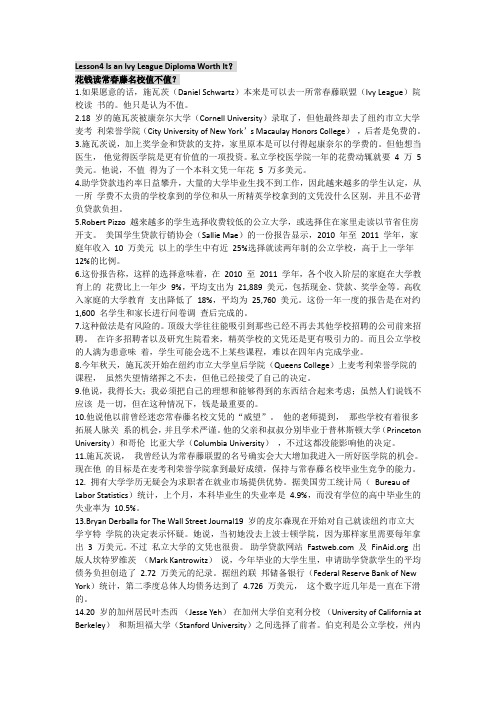美英报刊阅读教程Lesson 16 课文
Unit 16 The United States of America

Unit 16 The United States of AmericaUnit 16 The United States of America教案编号27Unit 16 The United States of America教案编号28Unit 16 The United States of America 教案编号29Unit 16 The United States of America教案编号30Unit 16 The United States of America教案Ⅰ.Brief Statements Based on the UnitThe United States of America is a developed country and also a booming country,which has a history of only 200~300 years.After the USA was founded,the American Civil War broke out in 1861,which brought suffering to the people of the USA,especially those in the South.Rebuilding the South became an essential task at that time.This unit mainly talks about the rebuilding and development of the American South.And Atlanta is a good illustration.It also deals with the bison on the plainsof America.Because the bison was killed in huge numbers by European settlers,the balance of the whole wildlife was destroyed.After learning the unit,we let the students learn about the early history of America.Besides,some useful expressions and phrases should be mastered,and Non-finite verbs need to be reviewed,especially their passive forms.Ⅱ.Teaching Goals1.Talk about the USA.2.Practise describing places.3.Review Non-finite Verbs(2).4.Write a comparison essay.Ⅲ.Background Information1.The American Civil WarThe war of 1861~1865 between the northern states (the Union) and the southern states (the Confederacy) is also called the War between the States or the War of the Rebellion.There were many causes,of which the most important were disagreement over slavery,and the quarrel concerning Federal control and States’Rights.The direct cause of the war was the election of Lincoln as President;this was followed by the secession of the southern states from the Union and the founding of the Confederacy,with Jefferson Davis as its President.The North had many advantages,a far greater population,more railway lines,and more factories.But the Confederates fought hard and were at first successful:they won the battles of Bull Run and Fredericksburg;but then Lee was defeated at Gettysburg and the Union army led by Grant won control of Mississippi.Admiral Farragant forced New Orleans to surrender:Texas,Arkansas and Louisiana were cut off from the rest of the Confederacy.After the Union won the Vicksburg campaign,Sherman made his march through Georgia to the sea,and Lee surrendered to Grant at Appomatton Court House,Virginia,on April 9,1865.Lincoln was assassinated in the same month.Slavery was declared unconstitutional.The period after the war (Reconstruction),when the South was occupied by the Worth,left bitterness that has not yet entirely vanished.During Reconstruction the southern states were admitted back into the Union.2.The War of American Independence(Also called the Revolutionary War 1775~1783)The struggle of the thirteen British colonies in North America for independence ended in the forming of the USA.The main causes of the war were taxes imposed by the British government,e.g.the Stamp Tax of 1765 and the Tea Tax.The colonies rebelled in 1775;the first shots were fired at Lexington,and the First battle was faught at Bunker Hill.The continental Congress appointed General Washington as leader of its forces,and issued the Declaration of Independence on July 4,1776.General Burgoyne led a British army down from Canada but was forced to surrender at Saratoga (Oct.1777).He was supposed to meet the army of General Howe,who managed to occupy Philadelphia.Washington spent the hard winter of 1777~1778 at Valley Forge,and had difficulty in keeping his men together,France (1778),Spain (1779)and the Netherlands (1780)joined the war against Britain.British forces under Cornwallis won victories in the South where Britain had some popular support,but Cornwallis was defeated at Yorktown,Virginia,and forced to surrender (Oct.19/1781),which practically brought the war to an end.At sea,Britain had to fight to keep her naval supremacy,but after Yorktown the American ports were lost one by one.The war was ended by the Treaty of Paris,1783,which recognized the independence of the USA.3.Slavery in the United StatesThe African ancestors (祖先) of today’s black Americans were brought to the US as slaves in the seventeenth,eighteenth,and nineteenth centuries.They worked on farms,especially the large farms in the southern states.Slowly they became a necessary part of the economic (经济) system (体制) of the South.Slaves did not have the right of people;according to the law,they were a “thing”which belonged to the person who bought them.They had to obey the orders of their owners without questions.They were not allowed to learn to read;their owners feared the educated slaves would begin to think about the injustice of the system and would learn to struggle for their freedom.Slaves had to work long hours in very unhealthy conditions.Their owners had complete power over them.They could be bought and sold like animals.At the slave markets,black children were separated from their parents and never allowed to see them again.Slave owners had the right to punish the slaves who broke the law or was against the system.Slaves were often beaten or even killed by their owners.After the Civil War,one free slave reported that his owner killed an older slave who wasteaching him to read.In theory an owner who treated a slave badly could be punished.In practice,however,the law meant nothing.Opposition to slavery began very early in the history of the US—in 1671—but little progress was made until the beginning of the nineteenth century.By 1804 slavery was illegal (非法的) in the northern states.But it continued,and even grew,in the southern states,which depended on cotton for their economic wealth.Slavery,ended in the South only after the Civil War.For blacks,however,the end of slavery was only a beginning,the late beginning of a long and difficult struggle for true justice.Ⅳ.Teaching Time:Five periodsThe First PeriodTeaching Aims:1.Learn about the USA.2.Do some listening.3.Practise describing places to train the students’ speaking ability.Teaching Important Points:1.Train the students’ listening ability.2.Improve the students’ speaking ability by practising describing places using the following useful sentence patterns:How long/wide/high/tall is the…?It’s…metres/feet long/wide/high/tall.There is…in the North.It looks like…Teaching Difficult Points:1.How to improve the students’ listening ability.2.How to help the students carry out the task of speaking.Teaching Methods:1.Listening-and-answering activity to help the students go through with the listening material.2.Discussion to help the students learn about the US.3.Individual,pair or group work to make every student have a chance to work in class.Teaching Aids:1.the multimedia2.the blackboardTeaching Procedures:Step ⅠGreetingsGreet the whole class as usual.Step ⅡLead-inT:Now,let’s begin our class.First,I’ll give you some information about the history of a country.Please guess which country it is.Listen carefully.It is a very young country in the world,which has only a history of 200~300 years.Most people in the country are immigrates The head office of the UN was set up there.Two World Wars didn’t take place there.Now it is the strongest country of the world.Can you guess it?Ss:Yes.The USA.Step ⅢWarming-upT:You’re right.Today we’re going to learn Unit 16 The United States of America (Bb:Unit 16 The United States ofT:Well,please do it by yourselves.After a while,I’ll check your answers.Is that clear?Ss:Yes.(After a few minutes,teacher checks the students’ answers.)T:The first one,true or false?S1:False.T:Please correct it.S1:New York is the largest city in the US.T:Good.The second one?S2:True.T:What about the third one?S3:False.New York is known as the “Big Apple”.…Suggested answers:4.F The Constitution was written in 1787.5.F There are 50 stars on the American flag.6.T7.T8.F The Mississippi is one of the important rivers in the world.T:A good job!Now,open your books and turn to Page 41.Please look at the map of the USA and find out the following cities and states:New York,Washington,Florida,Taxas, California,Alaska.(A few minutes later,teacher says the following.)T:Please look at the first picture.What place is it?Any volunteer?S4:It is the famous White House,where the president of the US works and lives with his family.T:Do you know how it got its name?S4:No.T:Who knows?S5:At first,it was made of gray stone and called the President’s Palace.During the war of 1812,it was burned by British soldiers.Afterwards,it was rebuilt.The walls were painted white to cover up marks left by the fire.Then people began calling the President’s Palace the White House.The name caught on and has remained in use ever since.T:Wonderful!Next,let’s look at the second picture.It is a famous city,which is it?S6:New York.T:Right.Can you guess when the picture was taken?S6:I think it was taken before the date September 11,2001.T:How do you know?S6:Because in the picture,we can see many skyscrapers.Among them,the World Trade Centre and the Empire State Building are most famous,but now the World Trade Centre has already gone.It was exploded by terrorists.T:Oh,What a pity!Do you know anything else about New York?Ss:No.T:New York is America’s cultural capital,where there is the statue of Liberty,the skyscrapers, the beautiful shops on Fifth Avenue,and the many theatres on Broadway.Manhattan,the smallest island in New York,is the real centre of the city.When people say “New York City”they usually mean Manhattan.In 1605,the first Europeans came to Manhattanfrom Holland.They bought the island from the American Indians for a few glass necklaces,worth about $26.The most crowded part of New York is perhaps Harlem,where most Black Americans live.The crime rate is among the highest in the Western world.I hope one day some of you will have a chance to visit it.Do you have enough confidence?Ss:Yes.T:OK.Now,work in pairs or groups.Make a list of things you know about the USA and what you’d like to know more about.(Teacher may encourage the students to make a chart.Several minutes later,teacher collects their charts.)Sample diagram:Step ⅣListeningT:OK.We have talked more about the USA.Now let’s listen to a radio programme about New York to help Wang Xiao correct the errors in her notes.Turn to the next page.Let’s look at Ex.1 in the listening part.Here are the notes taken by Wang Xiao after he listens to a radio programme about New York.First read it by yourself.Then I’ll play the tape for you to listen.After that,please correct his errors.(Teacher plays the tape for the first time.After playing it,teacher gives the students one or two minutes to do Ex.1.At last,teacher checks the answers with the whole class.)T:OK.Now let’s listen to the tape again and then answer some concerned questions.Before listening,you need to go through with the questions.(Teacher gives the students one minute to read the questions.Then play the tape for the second time.After that,give the students enough time todiscuss the answers and check them.)T:Well done.Please listen to Part 2 of the listening material and then choose the best answers to the question in Ex.3.(Teacher deals with Ex.3 in the same way.If necessary,play the tape again.)Step ⅤSpeakingT:Everyone loves his own hometown,which is beautiful in their hearts.Now,let’s talk about our hometown.Tell me where your hometown is,Wang Kai.S7:My hometown lies on the plain of North China.T:Are there any mountains,rivers or forests?S7:Yes.There is the famous Mount Taihang to the west,Fenhe River in the centre and a railway from Datong to Fenglingdu across my hometown.T:What does the landscape look like?S7:Very beautiful.There are thick forests,clean rivers and pleasant climate.Resources of minerals are also rich,which is called “the Sea of Coal”.Many places of interest,like the ancient city Pingyao,Yungang Rock Cave and Mount Wutai are famous in the world.T:Well done!Now,look at the last part—Speaking at Page 42.Let’s do some speaking.Choose one of the cards and ask each other questions.You can use a map to help you.Before speaking,please look at the sentence patterns on the screen.They may be of great help to you.Can you make a sentence using each sentence pattern on the screen?Ss:Yes.T:Who can try the first sentence pattern?S8:How tall is the building?T:Yes.Answer the question,please.S8:It’s about 100 feet tall.T:Very good.Make a sentence with the next sentence pattern.Any volunteer?S9:There is a famous mountain in the north.T:OK.Sit down,please.The last one?S10:It looks like a bird’s nest.T:Good job!Now,work in pairs to talk about your hometown.Ater a while,I’ll ask some students to act out their dialogues before the class.Are you clear about that?Ss:Yes.T:Begin,please.(Teacher goes among the students and joins them.)T:(After a few minutes)Are you ready?Ss:Yes.T:Who’d like to act out your dialogue in front of the class?(Two students stand up and act out their dialogue before the class.)Sample dialogue:A:Could you tell me where your hometown is?B:My hometown is on the plain of North China,which has a population of 5 000.A:Is it beautiful?B:Yes.It lies to the east of Mount Taihang and west of Haihe River.The railway from Beijing to Guangzhou crosses it.There is fertile land,rich resources,simple people and developed trade.It is a brilliant pearl on the plain.A:Very beautiful!Would you like to take me to visit your hometown if possible?B:Of course.I’m glad to act as your guide.What about your hometown?A:On the Loess Plateau lies my hometown.B:The Loess Plateau?It must be very inaccessible and backward.A:No.My hometown is not far from the Yellow River,which is more than 5 000 metres long.The traffic is convenient,four seasons clear,climate cool and resources of minerals rich,like coal,iron…I believe my hometown will become more beautiful in the near future.Step ⅥSummary and HomeworkT:In this class,we’ve mainly learnt something about the USA by speaking and listening.Besides,we’ve talked about our hometown using the useful sentence patterns,such as:How long/wide/high/tall is the…?It’s…metres/feet long/wide/high/tall.…(Teacher writes them on the blackboard.)After class,surf the Internet to get more information about the USA,such as the history of the USA.At last,don’t forget to preview the reading passage.That’s all for today.Class is over.Reference for TeachingⅠ.异域风情Weddings in the U.S.Weddings in the United States vary as much as the people do.There are church weddings with a great deal of fanfare1;there are weddings on mountain-tops with guests barefooted2;and there have been weddings on the ocean floor with oxygen tanks for the guests.But many weddings,no matter where or how they are performed,include certain traditional customs.Before a couple is married,they become engaged.And then invitations are sent to those who live nearby,their close friends and their relatives who live far away.When everything is ready,then comes the most exciting moment.The wedding itself usually lasts between 20 and 40 minutes.The wedding party enters the church while the wedding march is played.The bride carrying a bouquet enters last with her father who will “give her away”.The groom enters the church from a side door.When the wedding party is gathered by the altar3,the bride and groom exchange vows.It is traditional to use the words “To have and to hold from this day forward,for better,for worse,for richer,for poorer,in sickness and in health,to love and to cherish,till death do us part”.Following the vows,the couple exchange rings.Wearing the wedding ring on the fourth finger of the left hand is an old custom.After the ceremony4 there is often a party,called a “reception”which gives the wedding guests a chance to congratulate the newlyweds.The car in which the couple leaves the church is decorated5 with balloons,streamers and shaving cream.The words “Just Married”are painted on the trunk or back window.The bride and groom run to the car under a shower of rice thrown by the wedding guests.When the couple drives away from the church,friends often chase them in cars,honking6 and drawing attentionⅡ.知识归纳1.浅析非谓语动词的被动式结构非谓语动词的逻辑主语是该非谓语动词动作的承受者时,一般要用非谓语动词的被动式。
《英美报刊阅读》ppt课件(2024)

情感目标
通过本课程的学习,学生应增强对英美文化的了解 和认识,培养跨文化意识和国际视野。
2024/1/29
5
教材及辅助资料
教材
《英美报刊阅读教程》(第二版), 高等教育出版社。
辅助资料
英美主流报刊杂志(如《纽约时报》 、《泰晤士报》、《经济学人》等) 、新闻网站(如BBC、CNN、VOA等 )、多媒体教学课件等。
2024/1/29
02
在阅读社会文化类文章 时,如何运用背景知识 帮助理解?
03
04
如何评价社会文化现象 对社会和个人的影响?
在现代社会中,如何看 待和传承传统文化?
24
06
科技环保类文章阅读与解析
2024/1/29
25
科技环保类文章特点及背景知识
科技环保类文章的主要特点
聚焦科技与环保的结合点,探讨新技术在环保领域的应用。
探讨文章中的政治术语 、隐喻和修辞手法,以 及它们如何传递作者的 意图和态度。
评价文章的客观性和公 正性,以及可能存在的 偏见和误导。
2024/1/29
13
思考与讨论
01
02
03
04
思考政治类文章对读者的影响 ,如何提高读者的政治觉悟和 批判性思维能力。
思考政治类文章对读者的影响 ,如何提高读者的政治觉悟和 批判性思维能力。
分析社交媒体在青少 年中的普及程度和使 用情况。
2024/1/29
例子二:解析某篇报 道中关于“社交媒体 对青少年影响”的讨 论。
22
实例分析:社会文化现象解读
2024/1/29
01
探讨社交媒体对青少年社交、心 理、行为等方面的影响。
02
思考如何引导青少年合理使用社 交媒体。
英美报刊选读Lesson 16

• BOTOX (肉毒杆菌) BOTOX® is widely used as a cosmetic enhancement to temporarily reduce wrinkles and fine lines in the face, banish neck bands (颈砸), and clear away crow's feet (鱼尾纹). BOTOX® was approved by the FDA for non-cosmetic use in 1989 and approved for cosmetic use in 2002.
• Ear Surgery is usually done to set prominent ears back closer to the head, or to change the shape or reduce the size of large ears. • Eyelid Surgery removes fat and excess skin from the upper and lower eyelids, and can be done alone or in conjunction with other facial surgery procedures such as a facelift or browlift.
Most Popular
• Body Thermage (电波拉皮) An exciting new cosmetic procedure that provides a non-surgical alternative for tightening loose skin and wrinkles through the use of radiofrequency energy. It is typically used to treat the neck, face, eyes, abdomen, thighs, upper chest, and buttocks. Other parts of the body can be treated as well.
英美报刊文章阅读精选本第五版课文翻译

Lesson4 Is an Ivy League Diploma Worth It?花钱读常春藤名校值不值?1.如果愿意的话,施瓦茨(Daniel Schwartz)本来是可以去一所常春藤联盟(Ivy League)院校读书的。
他只是认为不值。
2.18 岁的施瓦茨被康奈尔大学(Cornell University)录取了,但他最终却去了纽约市立大学麦考利荣誉学院(City University of New York’s Macaulay Honors College),后者是免费的。
3.施瓦茨说,加上奖学金和贷款的支持,家里原本是可以付得起康奈尔的学费的。
但他想当医生,他觉得医学院是更有价值的一项投资。
私立学校医学院一年的花费动辄就要4 万5 美元。
他说,不值得为了一个本科文凭一年花5 万多美元。
4.助学贷款违约率日益攀升,大量的大学毕业生找不到工作,因此越来越多的学生认定,从一所学费不太贵的学校拿到的学位和从一所精英学校拿到的文凭没什么区别,并且不必背负贷款负担。
5.Robert Pizzo 越来越多的学生选择收费较低的公立大学,或选择住在家里走读以节省住房开支。
美国学生贷款行销协会(Sallie Mae)的一份报告显示,2010 年至2011 学年,家庭年收入10 万美元以上的学生中有近25%选择就读两年制的公立学校,高于上一学年12%的比例。
6.这份报告称,这样的选择意味着,在2010 至2011 学年,各个收入阶层的家庭在大学教育上的花费比上一年少9%,平均支出为21,889 美元,包括现金、贷款、奖学金等。
高收入家庭的大学教育支出降低了18%,平均为25,760 美元。
这份一年一度的报告是在对约1,600 名学生和家长进行问卷调查后完成的。
7.这种做法是有风险的。
顶级大学往往能吸引到那些已经不再去其他学校招聘的公司前来招聘。
在许多招聘者以及研究生院看来,精英学校的文凭还是更有吸引力的。
美英报刊阅读教程ppt课件

美英报刊阅读教程ppt课件目录CONTENCT •报刊阅读概述•美英报刊阅读技巧•美英报刊常见题材与写作风格•美英报刊词汇与语法特点•美英报刊文化背景知识•美英报刊阅读实践01报刊阅读概述报刊的重要性信息传递报刊是传递信息的重要途径,包括新闻、时事、社会动态等。
文化传承报刊作为文化载体,能够传承和弘扬社会文化。
思想交流报刊为人们提供思想交流的平台,促进不同观点和思想的碰撞与融合。
报刊的种类和特点种类包括日报、周报、月报等,涵盖政治、经济、文化、娱乐等各个领域。
特点具有时效性、真实性、客观性等特点,同时不同种类的报刊还具有各自独特的特点,如深度报道、评论分析等。
01020304提高语言能力了解国际动态拓展知识面培养批判性思维报刊阅读的目的和意义英文报刊涵盖各个领域的知识和信息,有助于拓展知识面和视野。
英文报刊是获取国际新闻和时事动态的重要途径,有助于了解全球发展趋势和热点事件。
通过阅读英文报刊,可以提高英语语言能力,包括词汇、语法、阅读理解能力等。
英文报刊中的评论和分析有助于培养批判性思维和独立思考能力。
02美英报刊阅读技巧80%80%100%阅读前的准备明确自己希望通过阅读获得哪方面的信息或知识,以便有针对性地选择阅读材料。
对于所选主题或话题,提前了解相关背景信息,有助于更好地理解文章内容。
根据标题、副标题、图片等线索,预测文章可能涉及的内容,为阅读做好准备。
确定阅读目的了解背景知识预测文章内容略读(Skimming)快速浏览全文,抓住文章大意和中心思想,确定文章是否符合阅读目的。
扫读(Scanning)寻找特定信息或关键词,如人名、地名、数据等,以便快速定位到所需内容。
精读(Intensive Reading)仔细阅读文章重要部分,理解作者观点、论据和细节信息。
批判性思维对文章内容进行批判性分析,评估作者观点的合理性和可信度,形成自己的见解。
回顾文章内容总结阅读收获分享与交流反思与改进简要回顾文章的主要观点和论据,加深对文章内容的理解。
2024版美英报刊阅读ppt课件

05 美英报刊中的广 告与文化
广告的种类与特点
商业广告
宣传商品或服务,吸引消费者购买。
公益广告
宣传社会公益事业或道德观念,提高 公众意识。
广告的种类与特点
• 政治广告:宣传政治人物或政策主张,影响公众舆 论。
广告的种类与特点
针对性强
针对不同受众群体,制定相应的广告 策略。
信息量大
传递大量信息,包括产品特点、品牌 形象等。
03 美英报刊中的新 闻报道
新闻报道的结构与特点
01
02
03
04
05
标题(Headline) 导语(Lead)
简洁明了,概括新闻主题
开篇引入,激发读者兴趣
正文(Body)
结尾 (Conclusi…
特点
详细阐述新闻事件,包括时 间、地点、人物、事件等要 素
总结新闻事件,可能包含评 论或预测
时效性、真实性、客观性、 重要性、接近性、显著性、 趣味性等
让读者能够全面了解事件背景和各方立场。
04 美英报刊中的评 论与专栏
评论与专栏的种类与特点
社论
代表报刊立场,对重大事件或问题 进行深入分析。
专栏评论
由特定作家撰写,表达个人观点, 风格多样。
评论与专栏的种类与特点
• 读者来信:反映公众意见,提供不同视角。
评论与专栏的种类与特点
时效性
紧跟时事热点,迅速反应。
通过设置悬念,激发受众的好奇 心,引导他们关注广告内容。
突出亮点
强调产品或服务的独特之处和优 势,吸引受众眼球。
情感共鸣
运用情感因素,触动受众的情感 共鸣点,增强广告的影响力。
广告与文化的关系与影响
广告是文化的重要载体
英美报刊选读Lesson 16ppt课件

• Ear Surgery is usually done to set prominent ears back closer to the head, or to change the shape or reduce the size of large ears. • Eyelid Surgery removes fat and excess skin from the upper and lower eyelids, and can be done alone or in conjunction with other facial surgery procedures such as a facelift or browlift.
• Cheekbone Implants create the appearance of higher, more prominent cheekbones and better facial balance. Chin Surgery increases or reduces the length and projection of the chin.
• Forehead/Brow Lift is often done in conjunction with blepharoplasty睑成形术 to improve brow positioning, minimize frown lines and reduce forehead wrinkles. • Lip Enhancement can reshape the upper and lower lip to give a more aesthetic or youthful appearance. Augmentation of the lips is accomplished using various materials that help "plump" the lips, creating fullness and decreasing vertical lines.
《美英报刊阅读教程》

《美英报刊阅读教程》
端木义万
Free Powerpoint Templates
Page 1
Lesson 6
D.C. Influentials
By David T. Cook and Gail Russell Chaddock
Key to Questions
Photos & Diagrams
Additional Notes
Background Information
The lobbying exists in many countries, but the most developed is in America. Washington can be regarded as the street of lobby.
change their positions in this process.
Background Information
The existence of lobbying in America has the following four reasons.
- 1、下载文档前请自行甄别文档内容的完整性,平台不提供额外的编辑、内容补充、找答案等附加服务。
- 2、"仅部分预览"的文档,不可在线预览部分如存在完整性等问题,可反馈申请退款(可完整预览的文档不适用该条件!)。
- 3、如文档侵犯您的权益,请联系客服反馈,我们会尽快为您处理(人工客服工作时间:9:00-18:30)。
Lesson 16 The Price of BeautyThe government’s sudden decision to ask for a halt to breast-enlargement operations because they might be unsafe has terrified 2m women who have had them. Is America’s obsession with looking good unhealthy?11. “Get in shape” orders the cover of the latest issue of Los Angeles magazine. Alongside articles detailing where Madonna works out and recommending “apres-shop spas2” are familiar advertisements offering a quicker route to beauty through “facial sculpture”, liposuction and breast enhancement3. Cosmetic operations, once closely kept secrets, now appear as prizes in southern Californian charity raffles4. Meanwhile morticians complain that silicone implants, which do not burn, are clogging up their crematoriums.52. Los Angeles, a desert city which made up for its lack of natural endowments by stealing other people’s water and building its own port, is an appropriate capital for America’s $3 billion cosmetic-surgery industry. Nearly half the world’ s cosmetic surgeons live in America; a third of those work in California. Cosmetic surgery arguably began in San Francisco in 1964 when a topless dancer, Carol Doda, caused a national sensation by increasing her appeal with the help of 20 silicone injections.3. Until recently the most remarkable thing about cosmetic surgery in America, was how unremarkable it was. There were probably 2m cosmetic “procedures” in 1991-six times the total in 1981. It is no longer news that stars such as Michael Jackson, Liz Taylor and Cher have “gon e under the knife”; one talk-show hostess, Joan Rivers, talks about her body’s ebbs and flows as if they were as natural as the tides.64. Now those “effortless’ good looks seem a little more risky. Allegedly, the silicone implants can leak and interfere with the body’s immune system. There have been over 2,000 complaints, particularly about implants which predate 1985-although cosmetic surgeons blame zealous lawyers for manufacturing concerns.7 The Food and Drug Administration (FDA) announced an inquiry last year, but initially said it would not ask for the operations to stop before it reported. It changed its mind on January 6th, reportedly because of evidence coming out in court cases. In December, for example, a woman who suffered from a ruptured implant8 was awarded $7.34m from the biggest maker of implants, Dow Corning.5. The announcement has caused more panic among American women than any medical decision since a contraceptive device9, the Dalkon Shield, was removed from the market in 1974. Some 2m women have had implants, 80% of them for cosmetic reasons; the rest had “reconstructive” medical surgery following cancer treatment. The waiting list for implants by one Californian doctor used to be six months; it is now less than one month. Shares in implant makers have slumped.106. Such second thoughts are overdue.” For all its glittering advocates, cosmetic surgery is the only type of medicine where a perfectly healthy patient is cut up. (This, of course, omits reconstructive operations to repair burns or replace missing breasts.) Eight out of ten cosmetic operations are performed outside proper hospitals-some in operating rooms that look more like offices. Warnings of side-effects rarely appear in advertisements; nor do the records of the eager surgeons. Since it is “elective” surgery, not covered by insurance, few of the normal rules apply.7. Inside the industry rumours of malpractice are rife12. One senior plastic surgeon says that hehas a list of peers who he “wouldn’t let touch my dog’s haemorrhoids”.13 The American Medical Association seldom intervenes; neither, until recently, did the FDA. The cosmetic industry itself is split into several warring associations, who refuse to co-operate even on statistics, let alone standards and certification14.Bigger and bigger8. New rules may discipline the industry, but they are unlikely to stop it growing unless the American obsession with physical beauty sours. So far, surgeons say the recession has done more harm to their business than the bad publicity about breast implants; hence their confidence that trade will pick up. That still leaves two questions unanswered: why is cosmetic surgery so popular in America; and, even if it is safe, is it a good thing?9. A string of global industries-fashion, cosmetics, fitness-show that it is not just Americans who want to look good. A few countries, notably Brazil and Japan, have fast-growing cosmetic-surgery businesses. But America stands out as the only country where cosmetic surgery carries virtually no stigma. That is partly the result of good marketing. As many as 15,000 doctors now rely on cosmetic surgery for a fair chunk of their income-and they are allowed to advertise aggressively.10. However, on the whole, America’ s cosmetic-surgery business has been built on demand rather than supply. That demand comes from Americans of all ages, classes and races. One recent survey found that nearly one in three patients had an income below $25,000 a year-not much when most operations cost over $3,000.11. According to the American Academy of Cosmetic Surgery, breast enlargement, which costs between $2,000 and $4,000, was only the tenth most popular cosmetic procedure in 1990. Topping the wish list was sclerotherapy (the removal of spider veins15 in the legs), followed by collagen injections to get rid of facial lines, then nose-jobs, lip-jobs and liposuction (fat removal). But among clients of the rival American Society of Plastic and Reconstructive Surgeons, breast enlargement, collagen injections and eyelid surgery were roughly equal as the three most popular operations.12. When pushed to defend their trade, cosmetic surgeons argue that “vanity surgery” is often just an extension of reconstructive surgery. For example, redesigning the nose of a young boy, perpetually :eased because of his prominent conk16, can turn a problem teenager into a well-adjusted man. Cosmetic survey follows two great American traditions: a refusal to surrender to an environment and a willingness to give people a second chance. What is the difference, some ask, between removing excess fat in an hour on the operating table and three months in the gym? “I don’t intend to grow old gracefully,17” says a woman in a television advertisement for an ambitious skin cream, “I intend to fight it every step of the way.”13. Many, however, admit that there is a darker side. Psychologists point out that many operations are not to get rid of deformity18, but to make perfectly good looks even better. The Los Angeles Times recently reported that the beginning of the swimsuit season prompts a rush of breast implants; school reunions are good for the face-lift business.Growing old gracelessly14. Such competitive narcissism19 stretches into employment too. Larry Schoenrock of the University of California at San Francisco points out that good-looking people are more likely to get jobs. Most are women aiming to please prospective male bosses; but many male patients citetheir careers as the chief reason for going under the scalpel20.15. For ethnic minorities, the most popular operations are ones that change their racial characteristics. Asians want wider eyes; blacks want thinner lips. Critics say this is surrendering their identities to the white stereotypes that appear on the media. Surgeons say the point is more subtle: minorities want to de-emphasise rather than eradicate their looks21. For example, one Californian surgeon says that many blacks specifically ask that, after their operations, they should not look like Michael Jackson, who now has a “white” nose and “white” skin.16. Some trend-spotters22 detect the beginnings of a reaction against the knife. Non-surgical methods to reduce wrinkles, such as electronic massage machines, are selling fast. Last year the number of face-lifts completed increased by less than 1%. Cosmetic surgery can only hold back age; it cannot defeat it.23 Mr. Jackson, who has been described as the Peter Pan24 of the music industry, might reflect on Maurice Chevalier’s sanguine attitude25 to the appearance of a few wrinkles. “I prefer old age to the alternative,” he said.From The Economist, January llth, 1992。
